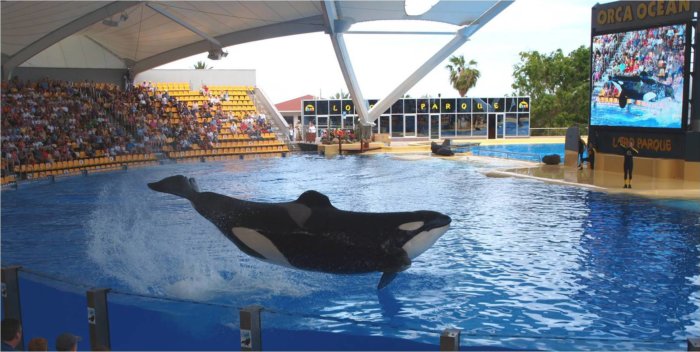Keto: Frustrated and Dangerous

By Christina Colvin
Frustration, violence and boredom: these are the central features of Keto’s life story.
Born in captivity in 1995, he currently lives at Loro Parque, a zoo and marine amusement park in Tenerife, Spain. Originally, all the killer whales there were on loan from SeaWorld, but now SeaWorld has sold them all off to the managers of Loro Parque.
Keto was born at SeaWorld Orlando, then shipped to SeaWorld San Diego, and then to SeaWorld San Antonio before being sent to Spain, where he continued to be trained and supervised by SeaWorld trainers. In the wild, orcas often live with the same family groups, called pods, their entire lives, so Keto’s multiple transfers between captive facilities and social circles was likely very stressful for him.
Beyond these basic facts from his personal history, we have little information about Keto’s personality and his favorite activities. What we do know is that his life has been marked by tragedy.
Keto kills his trainer
In 2009, Keto killed one of his trainers, a young man named Alexis Martinez. Unlike the major news coverage that followed Tilikum’s killing of trainer Dawn Brancheau at SeaWorld Orlando two months later, Keto’s killing of Martinez received almost no press at all at the time.
In “Blood in the Water,” journalist Zimmerman describes the living conditions the orcas experienced at Loro Parque. For instance, the protracted boredom caused by living inside a tank led them to seek “any possible diversion” from their ongoing experience of sameness. For example, they would use their teeth to peel away strips of Metflex, a rubber compound used for waterproofing. They tore at the Metflex like “bored kids picking at loose paint.”
And since the Loro Parque whales were not led by a dominant female, as would be the norm among orcas in the wild, the social situation at Loro Parque was likely characterized by stress, uncertainty and aggression as Keto and his tank mates jockeyed for position in the social order.
Journalist Elizabeth Batt analyzed a confidential incident report filed after Keto killed Martinez. Insiders attest that the report (filed, interestingly, by SeaWorld, not Loro Parque), indicates that “after Keto’s initial attack on Martinez, the trainer never surfaced again, meaning that the orca’s attack must have been swift and devastating. The report confirms that after just 40 seconds into the incident – Alexis appeared ‘motionless on Keto’s rostrum.’”
Former SeaWorld trainer Jeffrey Ventre suggests that Keto likely acted out of a sense of intense frustration. “From what I read, Keto gave a high energy attempt on a stand on spy hop,” he writes, “and didn’t receive a reward because the control trainer determined that it wasn’t good enough. So they repeated, and the same thing happened: High energy … no reward. Unfortunately, in this case, Alexis received the brunt of Keto’s frustration, leading to his death.”
We also know that Keto’s teeth are worn down, a likely sign of chewing at the sides of his tank. Keto has also been observed with mucus running from his left eye, a likely sign of irritation from the chemicals poured into the orcas’ pools.
We want Keto’s story to be full of more than tragedy. As Zimmerman writes, “A frustrated killer whale – whether it’s struggling with captivity, social structure, sexual tension, poor health, or training failures – is a potentially dangerous killer whale.” After all the instability and frustration that life in a concrete tanks has forced him to endure, Keto deserves the life he has never known, one in which he can make decisions independent of human demands and desires.
We believe he would have such a life at a seaside sanctuary, and a chance to finally author his own story.